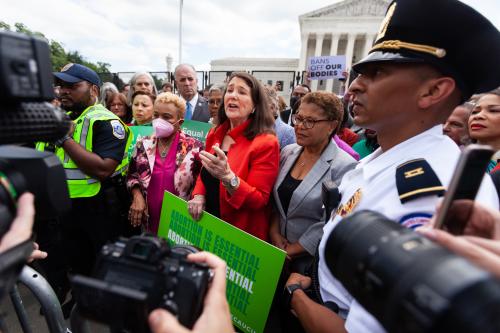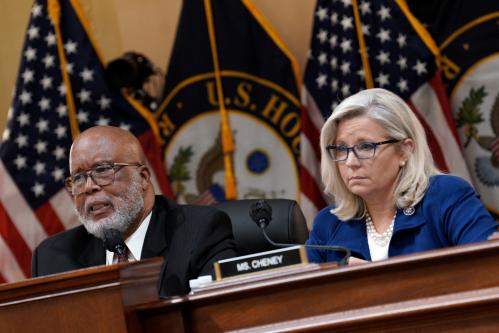The stakes for the 2022 midterm elections just got a lot higher. American democracy and majority rule, a cornerstone principle of our democracy, are on the ballot.
The recent decisions to overturn Roe v. Wade and to allow gun owners’ to carry a weapon in public reveal a Supreme Court far out of touch with the views of an overwhelming majority of Americans.
The attempted coup by former President Trump and his cronies, exposed by Republican witnesses at the explosive hearings of the January 6 special committee, represents the greatest threat to American democracy since before the Civil War.
And the continued success of pro-Trump election deniers in Republican primaries this year coupled with the reticence of far too many Republicans to renounce Trump’s brazen and illegal efforts to overturn 2020 election demonstrate that threat is ongoing.
“Our democracy is on a knife’s edge,” warned conservative judge J. Michael Luttig in testimony before the January 6 committee.
How can democracy in America, the constitutional republic that has been a model for free people everywhere for nearly 250 years be suddenly in trouble?
First, the vitality of any democracy depends on the ability of democratic institutions to keep pace with changing times. But in the last quarter century, important democratic institutions like the Senate, the Electoral College and the Supreme Court have not kept up with changes in our culture and the electorate. That failure has resulted in a structural imbalance in national politics.
Second, a vibrant democracy must be a nation of laws, not of men. We’ve had unscrupulous politicians throughout our history, but until now we’ve always been able to stop the rise of “cunning, ambitious, unprincipled men” who, George Washington warned in his farewell address, would “usurp for themselves the reins of government.” Trump, his cronies, and, to a lesser extent, Senate Republican leader Mitch McConnell have shown themselves to be the kind of men Washington warned us about.
The root of the institutional imbalance is in the structure of the United States Senate. Our founding fathers were men of great foresight, but in drafting the constitution, they could hardly have imagined the chasm that divides today’s America between the fast growing, populous, increasingly diverse states along the two coasts and the more numerous, more homogenous, less densely populated, slower growing states in between.
Because the constitution allots two senators to each state, regardless of population, the senate has in recent decades taken on a decidedly small state bias. For example, California, the nation’s largest state, and Wyoming, the nation’s least populous state, both get two senators despite the fact that California’s population is eighty times larger than Wyoming’s.
In fact, the population of California is bigger than the combined populations of the smallest 21 states.
That means that more than 39 million people in those 21 states have 42 votes in the Senate while the same number of people in California have just two. Since California votes Democratic by large margins, if those 44 senators were allotted on a per capita basis, they would overwhelmingly tilt Democratic by a margin of about three to one, or 33 to 11. But because each state gets two senators, and a majority of those 21 states vote Republican, the actual tally is 25 Republicans and 19 Democrats. That’s a swing of 28 seats. If you believe in one person one vote, the small state bias clearly puts Democrats at a significant disadvantage.
Just to break even in the Senate, Democrats need to win more of the national vote for Senate than the Republicans. With the even split in the current Senate, the 50 Democratic senators represent 56.5% of the voters, while the 50 Republican senators represent just 43.5% of the voters. In 2018, the Democrats won nearly 18 million more votes for Senate than the Republicans, but the Republicans still gained two seats.
Because so many Republican senators come from very small states, the last time they represented a majority of voters nationally was in 1996. But in seven of 12 Congresses since then, Republicans have held a majority of Senate seats.
Political data analyst David Shor projects that to have an even chance of holding on to the Senate this year, Democrats need to win the national vote for Senate by four points. If they win 51% of the national vote for Senate this year, they’ll likely lose a seat—and control of the Senate. And Shor’s model projects that in 2024 if the Democrats win that same 51% majority, they could lose seven seats.
The small state bias in the Senate carries over to the Electoral College since each state gets an Electoral College vote for each of its senators. So small states get proportionately more electors. As a result, political analyst Nate Silver estimates that a Democratic candidate must win the popular vote by at least three percentage points to have an even chance of winning in the electoral college.
That reality has never been more evident than in recent presidential elections. In the 25 presidential elections in the 20th century, not once did the candidate who lost the popular vote win the presidency in the Electoral College. But in the six elections in this century, that has already happened twice.
The Supreme Court by design inevitably lags behind the public will. Because justices have lifetime appointments, at any one time, the majority of the justices will have been appointed by a past president and, thus unlikely to reflect current majority opinion. The recent Roe and gun decisions are prime examples.
The three justices who cast the deciding votes in both cases were appointed by former President Trump who lost the popular vote (in 2016) by nearly three million votes and were confirmed by senators who represented less than 45% of the electorate. Trump, elected by a minority of voters, had three court appointments because McConnell manipulated Senate procedures to block confirmation of a justice appointed by President Obama, who twice won a majority of the popular vote.
In the best of all worlds, the two parties would get together to reform and modernize our institutions to eliminate their biases. But with today’s polarized politics, that’s not going to happen.
Instead, Republican leaders, as evidenced by McConnell’s manipulation of the Supreme Court confirmation process and Trump’s attempted coup, have exploited these institutional imbalances in order to cling to vital levers of power even though their coalition now represents a minority of voters.
Think about this: the Democrats have won the popular vote in seven of the last eight presidential elections, the longest winning streak for any party in American history, yet they have won the presidency only five times.[1]
The chances of changing the small state bias are slim to non-existent. Representatives from small states cannot be expected to amend the political deal that gave them such outsized power in the first place, particularly if, as most pundits predict, the Republicans, who benefit from it, win control of the House and Senate this year.
The only alternative is for Democrats to appeal beyond party lines to voters concerned about democracy and majority rule, even small state conservatives, and win House and Senate seats not only in traditional Democratic areas but also in districts and states that ordinarily vote Republican.
Admittedly, with voters dissatisfied with President Biden over high inflation and rising crime, that’s not likely to happen. Even in years that the political environment favors Democrats they have to over perform just to break even. But it’s not impossible as the Democratic sweep in the post-Watergate election of 1974 has shown. That was the last time the fate of our democratic system was on the line.
To win in normally hostile territory, Democrats will need to find new allies among all voters who want to preserve our democracy—independents, suburban voters, moderate and anti-Trump Republicans, and hardworking ordinary Americans—voters who would normally vote Republican but are appalled at the actions of Trump, his extremist MAGA supporters, and the McConnell Supreme Court.
That will require the Democrats to ditch their normal base-oriented midterm election strategy. They need to make this fall’s election about preserving democracy and majority rule. Democrats need to open their tent to all voters who share that grand purpose—regardless of party or ideology. Pressing partisan Democratic agendas, and pet programs will have to wait until our democratic system is secure. Progressives will have to understand that Democrats will not defeat Republican extremism by offering extreme ideas of their own.
The late Democratic political commentator Mark Shields once said that politics is about looking for converts, not punishing heretics. 2022 is not a year for ideological purity tests and punishing heretics. For the sake of our country, our democracy and the principle of majority rule, this year more than ever Democrats need to find more converts.
[1] Republicans won the popular vote in 2004.







Commentary
The challenge to democracy—overcoming the small state bias
July 6, 2022